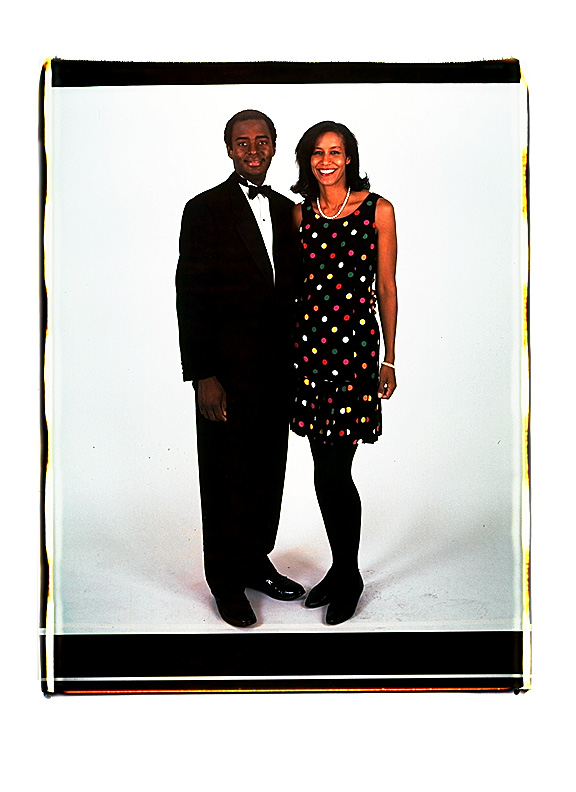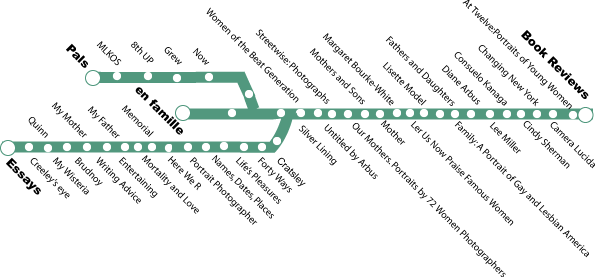

Most of my clients find me by word of mouth. They see my portraits in the living rooms, kitchens, and offices of their friends. The windows of the USTrust/Middlesex in Harvard Square, where I have a monthly display, at tracts many people. I also have a gallery/shop at Charles Square, next to the Charles Hotel, in Harvard Square where I have about eighty portraits on exhibit. Since there are so many connections between my clients, the gallery looks very familial.



 I help the situation along by making sure that all my clients have seen my work before they actually make an appointment for a sitting. That way I get people who have a good idea of what I do and who can sense whether or not we could get a good portrait. I never convince people that they should commission me. I almost talk them out of it. One thing that people are hesitant about is that I take only two exposures. (Curiously, the portraits don't get better, the more exposures are made.) I explain that if a person blinks, I absorb the cost and that if there is a technical flaw, like an incorrect exposure or a blip on the film, I absorb that cost too. Lots of people can't stand the fact that I take only two exposures. Understandably, it makes them very nervous. I am left with people who are willing to go for it. People who whether they realize it or not have made a commitment to our portrait session. Because my subject and I see one exposure before we make the next exposure, the work is collaborative. There are people who find it very hard to collaborate. They don't catch on and can't relinquish their power. I used to exhaust myself trying to cajole such people. But now I relax and make a portrait of their stubborness.
I help the situation along by making sure that all my clients have seen my work before they actually make an appointment for a sitting. That way I get people who have a good idea of what I do and who can sense whether or not we could get a good portrait. I never convince people that they should commission me. I almost talk them out of it. One thing that people are hesitant about is that I take only two exposures. (Curiously, the portraits don't get better, the more exposures are made.) I explain that if a person blinks, I absorb the cost and that if there is a technical flaw, like an incorrect exposure or a blip on the film, I absorb that cost too. Lots of people can't stand the fact that I take only two exposures. Understandably, it makes them very nervous. I am left with people who are willing to go for it. People who whether they realize it or not have made a commitment to our portrait session. Because my subject and I see one exposure before we make the next exposure, the work is collaborative. There are people who find it very hard to collaborate. They don't catch on and can't relinquish their power. I used to exhaust myself trying to cajole such people. But now I relax and make a portrait of their stubborness.
Many of my portraits are about affection. People pose with people they love or they pose to make a portrait for people they love. Many siblings have their portraits taken for their parents' twenty-fifth, thirtieth, fiftieth anniversary. (The most unusual groups of siblings were the seven O'Brien brothers--for their parents thirtieth--and Babe Parrott's eleven children. Occasionally, spouses will take their mates on a special "date" and bring them to the studio as a surprise. When people come back to me every two years or four years, as several have, my portraits are about growing up, growing older, life changes. Many portraits incorporate an earlier portrait of my subject. Bernard Baumann posed on his eighty-fifth birthday with a blow up of a snapshot when he was an officer in the
 Polish army in 1927. Marybeth Walsh and her sister Patty posed with a color portrait taken in Bradlees exactly a decade earlier. On their fortieth anniversary Tom and Rosemarie Costin posed holding their wedding album with its hand tinted photograph cover. Danny Mazur posed on his thirtieth birthday with two black and white portraits of himself that I made in l965 and l970. I often say to people who have their portraits done on their tenth, thirteenth, sixteenth, or twenty-first birthdays, "This portrait is a message to yourself at forty. Look to the person you want to become." There's a whole group who come to celebrate their survival. Two fa
milies lived through awful car crashes; one family lost everything they owned in a fire. Two families, mother and college-age children, came on the anniversary of the husband/father's death. Several people who had cancer--and who wanted a picture for the people they love, or with the people they love--came before they got really sick. What means the most to me, in all my picture-taking, is when someone tells me that their favorite picture of a loved one is the picture I took of them. My portraits have been at several memorial services and funerals--and in obituaries. After Paul Sutton's memorial service along the banks of the Charles River, his friends went to my shop at Charles Square to see my portrait of Paul and his daughter Leila, taken in 1986. When I heard that I was very moved and very grateful that I had taken the picture.
Polish army in 1927. Marybeth Walsh and her sister Patty posed with a color portrait taken in Bradlees exactly a decade earlier. On their fortieth anniversary Tom and Rosemarie Costin posed holding their wedding album with its hand tinted photograph cover. Danny Mazur posed on his thirtieth birthday with two black and white portraits of himself that I made in l965 and l970. I often say to people who have their portraits done on their tenth, thirteenth, sixteenth, or twenty-first birthdays, "This portrait is a message to yourself at forty. Look to the person you want to become." There's a whole group who come to celebrate their survival. Two fa
milies lived through awful car crashes; one family lost everything they owned in a fire. Two families, mother and college-age children, came on the anniversary of the husband/father's death. Several people who had cancer--and who wanted a picture for the people they love, or with the people they love--came before they got really sick. What means the most to me, in all my picture-taking, is when someone tells me that their favorite picture of a loved one is the picture I took of them. My portraits have been at several memorial services and funerals--and in obituaries. After Paul Sutton's memorial service along the banks of the Charles River, his friends went to my shop at Charles Square to see my portrait of Paul and his daughter Leila, taken in 1986. When I heard that I was very moved and very grateful that I had taken the picture.
I have a frank eye. It is open, makes contact, and doesn't THREATEN. I am interested in the surface appearance of the person. I don't try to strip off their so-called veneer. In fact, it is the veneer that attracts and charms me. I am perfectly comfortable with the idea that no portrait can ever be more than a version of the sitter. I don't worry that my clients may have had a fight in the parking lot three minutes before they came off the elevator smiling at me.
Find Elsa's Books
Please change your links and bookmarks to elsadorfman.com!
Elsa thanks her cybergodmother, photo.net, her longtime, most generous host at furfly.com, and her current web host Mike Sisk at TCP/IP Ranch, LLC.
Copyright 1970-2010 © Elsa Dorfman.
Inquiries for the use of Elsa's content are welcomed!
Please
read these guidelines.
Contact
Elsa Dorfman via email or send Website Feedback to her webmaster.






